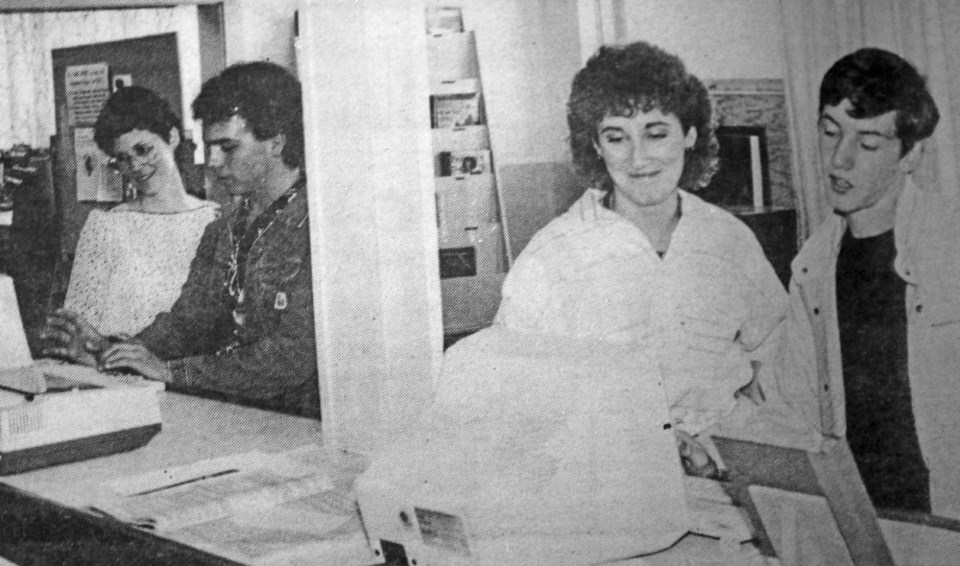The library computer system at TUCS is the pride of the Northeast, made possible by a mammoth undertaking by the Tisdale Unit Composite School, and the Tisdale School Division, both of whom recognize that a good school library is crucial to each. school in the Tisdale School Division.
Following Art Forgay’s Needs Administration Study of 1985/86, a media co-ordinator,Joan Kallechey, was hired to synchronize the library program in each of the schools.
Hardware to operate a Bibliofile data base (CD-ROM), the computers, and the software, all were installed during June, 1986. The results have only recently made themselves known.
As a direct result of the new system, librarians have been hired for each of the schools in the Tisdale division. As well, a card catalog has been set up in each of those schools, a library has been in set up in each school with in-services, basic collections, and/or weeding, and a computerized catalog and circulation system has been set up at TUCS. As well, plans to increase collections, complete. a union catalog for inter-borrowing within schools in the division is in the process.
At the TUCS library, compact disc players, similar to audio CDs, which access the Bibliofile database (all library cataloging information for most books published in Canada and the United States) are being utilized in place of the traditional floppy discs or computer cassettes that have been used in the past.
According to an article written for Computing Now! by Steve Rimmer: “The software that drives the encyclopedia is very colorful... I can’t see it being anywhere near as attractive on a monochrome screen, although it certainly can be configured to use one.”
“The encyclopedia is derived from Grolier’s Academic American Encyclopedia, which consists of about nine million words. In fact, this only takes up about 60 megabytes of disk space. The remaining 50 megabytes are an exhaustive index into the data, which contains buckets of pointers into the data to make the word search function of the driver software go.
“Most CD-ROM based applications have some temporal problems. They’re invariably quicker than doing information searches by hand, but you do spend a lot of time waiting. The encyclopedia is the fastest CD-ROM based system I’ve tried to date. Its responses to reasonable questions entail waits on the order of those one experiences when accessing moderately large files on a hard drive.”
Previously, cataloging books and typing cards for catalogs was a difficult and probably impossible task, especially in smaller schools. Such a project requires a good deal of time and training in the library.
Now, this chore is made easy with the new system which allows all the cataloging and making of cards for catalogs to be completed centrally from TUCS for all schools in the division. At TUCS, there is no longer a card catalog. Instead the students refer to an on-line catalog similar to what is used at the Northern Institute of Technology, the University of Saskatchewan and the Saskatoon Public Library.
This system allows students to look up books by authors, title, or subject and instantaneously tells the student whether or not the book is on the shelf. There was a tremendous amount of work through 1986/87 to set up the program and to catalog and label TUCS books. Bob Donnan set up the system and acted as troubleshooter for the system. Linda Lake, now of Lloydminster, was the library technician who, at that time, was in charge of entering the data. Deanna Gruending, TUCS librarian, planned and oversaw the project in conjunction with Joan Kallechy, Dwayne Brownridge (TUCS principal), and Don Sangster (Director of Education). As well, during the summer, a former student, Leanne Burgess, was hired to work on a special project to barcode and relabel TUCS books.
Presently, Deanne Oleksyn is working as the new library technician . She enters originally catalogued books, and has taken the challenge to take Mrs. Lake’s place in a matter of weeks. In late August, the TUCS circulation system was initiated. This means that, by means of barcoding and a light wand, the barcodes of TUCS library users and the materials they wish to borrow are paired, and thus checked out.
The CD-ROM hardware used for the cataloging also serves another function at TUCS. The entire 21 other volumes of the Academic American Encyclopedia can accessed from a single compact disc and a printout of any subject can be done.
The project has been an immense undertaking and has not been completed. However, Tisdale School Division has taken a lead in recognizing the importance of libraries, and of channeling, Education Development Fund money towards making recognizable difference in Tisdale and district schools. The TUCS Library extends an invitation to see the library in action during the Open House the evening of Parent/Teacher interviews.




